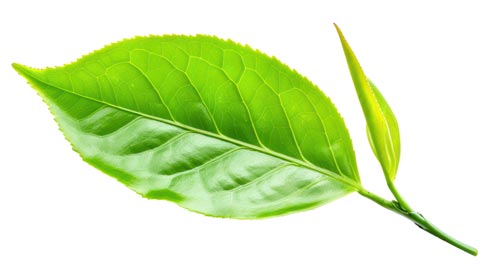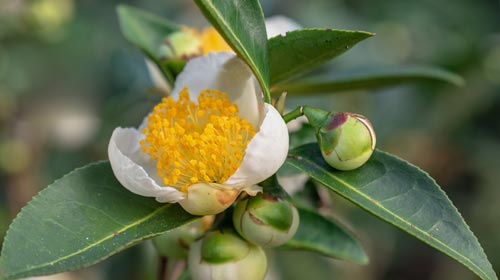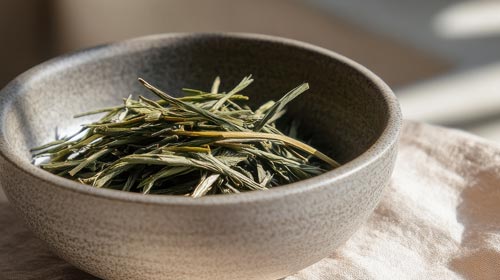A single leaf can change everything – at least when it's a Camellia sinensis tea leaf. It's the origin of millennia-old culture, rituals, moments of tranquility – and, of course, taste. But what exactly is contained in a tea leaf? And why is it worth taking a closer look?
First, the plant itself: Camellia sinensis is an evergreen shrub in the tea family (Theaceae). Its leaves are leathery, elliptical, and have fine, serrated edges. The size varies depending on the variety and growing conditions, but on average, a fully grown leaf measures between 5 and 12 centimeters.
What many people don't know: From a botanical perspective, the tea leaf is a small miracle. It consists of an upper and lower layer (epidermis), a multilayered palisade tissue, and a sponge-like tissue inside – the so-called mesophyll. This tissue is traversed by a clearly visible main vein and finely branched lateral veins. These leaf veins are responsible not only for water transport but also for the distribution of nutrients and aroma precursors.
Crucial to tea quality are the trichomes – tiny, downy hairs on young leaves and buds. They are rich in essential oils, flavonoids, and amino acids like L-theanine. The concentration of these substances is highest in the young shoots. This is precisely why the first two leaves and the unopened bud ("two leaves and a bud") are so sought after in traditional tea picking.
A single tea leaf contains over 700 volatile aromatic components. The aroma isn't concentrated in one spot—it's stored throughout the entire leaf tissue, embedded in cell walls, enclosed in glandular hairs, and bound to secondary plant substances. Through oxidation, steaming, or roasting, this aromatic potential is released in different ways. This is how the very different types of tea are created, even though they all come from the same leaf.
Leaf structure also plays a role: A denser network of leaf fibers—cellulose, hemicellulose, and lignin—provides stability but simultaneously slows fermentation. In more delicate, thin-walled leaves, these processes occur more quickly, resulting in a more delicate, often floral aroma.
We observe these differences with particular interest in our tea cultivation in Germany. Here, the leaves grow slower, denser, and develop complex aromas – an effect of cooler nights and balanced soils. These climatic conditions often lead to higher polyphenol content, which is reflected in an intense, often nutty or grassy-mineral profile.
The leaves themselves are not only carriers of flavor, but also an expression of the cultivation concept. At Growing Karma, our plants are grown in a living permaculture system, entirely without chemical fertilizers or growth accelerators. The leaves are allowed to take their time. And you can taste this time.
A nice side effect: If you rub the fresh leaf between your fingers, you'll immediately feel the plant's power. It exudes a fresh, sometimes almost citrus-like scent—depending on the variety, soil, and weather. This fresh aroma quickly dissipates when the leaf is picked—which is why we process it with particular care, often immediately after harvest.
From a botanical perspective, each leaf forms its own little world. The venation—the pattern of leaf veins—acts almost like a fingerprint. And it determines how water, nutrients, and aromas are transported and stored within the leaf. Each leaf contains countless micro-spaces, cell layers, and aroma chambers, which, together, shape the character of the resulting tea.
Perhaps you'll see the next tea leaf you encounter with different eyes. Not just as a carrier of flavor, but as a complex, living element of a plant that has been part of human culture for generations – and whose value extends far beyond the cup.
Ultimately, it's the leaf that carries everything: the knowledge, the fragrance, the season—and the care of cultivation. And when it comes from a Camellia sinensis that has been allowed to grow in peace and balance, it unfolds precisely that: a depth you can taste.




Leave a comment
This site is protected by hCaptcha and the hCaptcha Privacy Policy and Terms of Service apply.